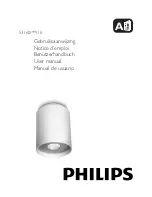
Assembly & Installation: GT-CB-25A | High Lumen 25W/2,500LM LED Bulb
Assembly & Installation: GT-CB-25A | High Lumen 25W/2,500LM LED Bulb
ADDITIONAL WARNINGS:
INSTALLATION INSTRUCTIONS:
L
(Live)
N
(Neutral)
L
(Live)
N
(Neutral)
E26 CFL
E26 LED Lamp
100-277
VAC
100-277
VAC
1. Before installing the bulb, shut off power supply at the circuit breaker panel
to avoid electrical shock. Ballast must be bypassed.
It is recommended that surge/lightning protection be installed.
2. Bulb may be mounted with the base up, down, or horizontal.
3. Remove old bulb.
4. Screw in new high lumen LED bulb.
5. Restore power & turn on light switch.
• This product is not rated for enclosed fixtures.
• DO NOT USE WITH DIMMER. This bulb is not compatible with dimmer switches.
(Using this lamp with dimmer of any kind will void the warranty.)
• Not compatible with photocell/motion sensors rated less than 150W.
• Not compatible with ballasted fixtures. Ballast must be bypassed if present.
If unsure how to retrofit MHZ/HPS light fixtures call a qualified electrician.
• Do not install this light inside of undersized enclosures.
• Do not dismantle this light. There are NO replaceable LEDs or serviceable parts.
• Do not use where exposed to water.
• Do not leave bare wires exposed outside of the electrical connections.
• Make sure wiring section is insulated.
This device complies with Part 15 of the FCC rules. Operation is subject to the following
two conditions: (1) This device may not cause harmful interference, and (2) this device
must accept any interference received, including interference that may cause undesired
operation. Warning: Changes or modifications to this unit not expressly approved by the
party responsible for compliance could void the user’s warranty and the authority to
operate the equipment. Note: This equipment has been tested and found to comply with
the limits for a Class B digital device, pursuant to Part 15 of the FCC rules. These limits are
designed to provide reasonable protection against harmful interference in a residential
installation. This equipment generates, uses, and can radiate radio frequency energy and,
if not installed and used in accordance with the instructions, may cause interference to
radio communications. However, there is no guarantee that interference will or will not
occur in a particular installation. If this equipment does cause harmful interference to
radio or television reception, which can be determined by turning the equipment off and
on, the user is encouraged to try to correct the interference by one of the following
measures:
1) Reorient or relocate the receiving antenna.
2) Increase the separation between the equipment and receiver.
3) Connect the equipment into an outlet on a different circuit from the receiver.
4) Consult the dealer or an experienced radio/TV technician for help.




















